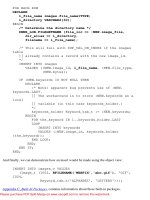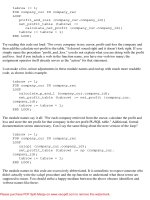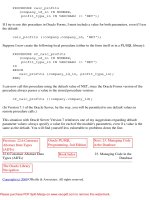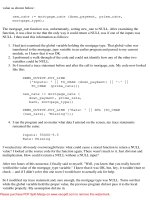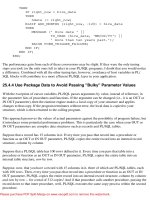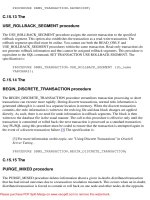Oracle PL/SQL Programming pdf
Bạn đang xem bản rút gọn của tài liệu. Xem và tải ngay bản đầy đủ của tài liệu tại đây (21.22 MB, 10,396 trang )
Oracle PL/SQL Programming
Table of Contents
Copyright
Dedication
Preface
Objectives of This Book
Structure of This Book
Conventions Used in This Book
Which Platform or Version?
About the Code
Safari Enabled
Comments and Questions
Acknowledgments
Part I: Programming in
PL/SQL
Chapter 1. Introduction to
PL/SQL
Section 1.1. What Is PL/SQL?
Section 1.2. The Origins of
PL/SQL
Section 1.3. So This Is PL/SQL
Section 1.4. About PL/SQL
Versions
Section 1.5. Resources for
PL/SQL Developers
Section 1.6. Some Words of
Advice
Chapter 2. Creating and
Running PL/SQL Code
Section 2.1. SQL*Plus
Section 2.2. Performing
Essential PL/SQL Tasks
Section 2.3. Calling PL/SQL
from Other Languages
Chapter 3. Language
Fundamentals
Section 3.1. PL/SQL Block
Structure
Section 3.2. The PL/SQL
Character Set
Section 3.3. Identifiers
Section 3.4. Literals
Section 3.5. The Semicolon
Delimiter
Section 3.6. Comments
Section 3.7. The PRAGMA
Keyword
Section 3.8. Labels
Part II: PL/SQL Program
Structure
Chapter 4. Conditional and
Sequential Control
Section 4.1. IF Statements
Section 4.2. CASE Statements
and Expressions
Section 4.3. The GOTO
Statement
Section 4.4. The NULL
Statement
Chapter 5. Iterative Processing
with Loops
Section 5.1. Loop Basics
Section 5.2. The Simple Loop
Section 5.3. The WHILE Loop
Section 5.4. The Numeric FOR
Loop
Section 5.5. The Cursor FOR
Loop
Section 5.6. Loop Labels
Section 5.7. Tips for Iterative
Processing
Chapter 6. Exception Handlers
Section 6.1. Exception-
Handling Concepts and
Terminology
Section 6.2. Defining
Exceptions
Section 6.3. Raising Exceptions
Section 6.4. Handling
Exceptions
Section 6.5. Building an
Effective Error Management
Architecture
Section 6.6. Making the Most
of PL/SQL Error Management
Part III: PL/SQL Program Data
Chapter 7. Working with
Program Data
Section 7.1. Naming Your
Program Data
Section 7.2. Overview of
PL/SQL Datatypes
Section 7.3. Declaring Program
Data
Section 7.4. Programmer-
Defined Subtypes
Section 7.5. Conversion
Between Datatypes
Chapter 8. Strings
Section 8.1. String Datatypes
Section 8.2. Working with
Strings
Section 8.3. String Function
Quick Reference
Chapter 9. Numbers
Section 9.1. Numeric
Datatypes
Section 9.2. Number
Conversions
Section 9.3. Numeric
Functions
Chapter 10. Dates and
Timestamps
Section 10.1. Datetime
Datatypes
Section 10.2. Getting the Date
and Time
Section 10.3. Interval
Datatypes
Section 10.4. Datetime
Conversions
Section 10.5. Date and
Timestamp Literals
Section 10.6. Interval
Conversions
Section 10.7. Interval Literals
Section 10.8. CAST and
EXTRACT
Section 10.9. Datetime
Arithmetic
Section 10.10. Date/Time
Functions
Chapter 11. Records
Section 11.1. Records in
PL/SQL
Chapter 12. Collections
Section 12.1. Collections
Overview
Section 12.2. Collection
Methods (Built-Ins)
Section 12.3. Working with
Collections
Section 12.4. Nested Table
Multiset Operations
Section 12.5. Maintaining
Schema-Level Collections
Chapter 13. Miscellaneous
Datatypes
Section 13.1. The BOOLEAN
Datatype
Section 13.2. The RAW
Datatype
Section 13.3. The UROWID
and ROWID Datatypes
Section 13.4. The LOB
Datatypes
Section 13.5. Working with
LOBs
Section 13.6. Predefined
Object Types
Part IV: SQL in PL/SQL
Chapter 14. DML and
Transaction Management
Section 14.1. DML in PL/SQL
Section 14.2. Bulk DML with
the FORALL Statement
Section 14.3. Transaction
Management
Section 14.4. Autonomous
Transactions
Chapter 15. Data Retrieval
Section 15.1. Cursor Basics
Section 15.2. Working with
Implicit Cursors
Section 15.3. Working with
Explicit Cursors
Section 15.4. BULK
COLLECT
Section 15.5. SELECT FOR
UPDATE
Section 15.6. Cursor Variables
and REF CURSORs
Section 15.7. Cursor
Expressions
Chapter 16. Dynamic SQL and
Dynamic PL/SQL
Section 16.1. NDS Statements
Section 16.2. Binding
Variables
Section 16.3. Working with
Objects and Collections
Section 16.4. Dynamic
PL/SQL
Section 16.5.
Recommendations for NDS
Section 16.6. When to Use
DBMS_SQL
Section 16.7. NDS Utility
Package
Part V: PL/SQL Application
Construction
Chapter 17. Procedures,
Functions, and Parameters
Section 17.1. Modular Code
Section 17.2. Procedures
Section 17.3. Functions
Section 17.4. Parameters
Section 17.5. Local Modules
Section 17.6. Module
Overloading
Section 17.7. Forward
Declarations
Section 17.8. Advanced Topics
Section 17.9. Go Forth and
Modularize!
Chapter 18. Packages
Section 18.1. Why Packages?
Section 18.2. Rules for
Building Packages
Section 18.3. Rules for Calling
Packaged Elements
Section 18.4. Working with
Package Data
Section 18.5. When to Use
Packages
Section 18.6. Packages and
Object Types
Chapter 19. Triggers
Section 19.1. DML Triggers
Section 19.2. DDL Triggers
Section 19.3. Database Event
Triggers
Section 19.4. INSTEAD OF
Triggers
Section 19.5. AFTER
SUSPEND Triggers
Section 19.6. Maintaining
Triggers
Chapter 20. Managing PL/SQL
Code
Section 20.1. Managing Code
in the Database
Section 20.2. Using Native
Compilation
Section 20.3. Using the
Optimizing Compiler and
Compile-Time Warnings
Section 20.4. Conditional
Compilation
Section 20.5. Testing PL/SQL
Programs
Section 20.6. Debugging
PL/SQL Programs
Section 20.7. Tuning PL/SQL
Programs
Section 20.8. Protecting Stored
Code
Chapter 21. I/O and PL/SQL
Section 21.1. Displaying
Information
Section 21.2. Reading and
Writing Files
Section 21.3. Sending Email
Section 21.4. Working with
Web-Based Data (HTTP)
Section 21.5. Other Types of
I/O Available in PL/SQL
Part VI: Advanced PL/SQL
Topics
Chapter 22. Application
Security and PL/SQL
Section 22.1. Security
Overview
Section 22.2. Encryption
Section 22.3. Row-Level
Security
Section 22.4. Application
Contexts
Section 22.5. Fine-Grained
Auditing
Chapter 23. Inside PL/SQL
Section 23.1. Looking Under
the Hood
Section 23.2. PL/SQL's
Optimizing Compiler
Section 23.3. Dependency
Management
Section 23.4. Execution
Authority Models
Section 23.5. PL/SQL and
Oracle Memory
Section 23.6. Server-Side
PL/SQL Processing: Reprise
Section 23.7. What You Need
to Know
Chapter 24. Globalization and
Localization in PL/SQL
Section 24.1. Overview and
Terminology
Section 24.2. Unicode Primer
Section 24.3. Character
Semantics
Section 24.4. String Sort Order
Section 24.5. Multilingual
Information Retrieval
Section 24.6. Date/Time
Section 24.7. Currency
Conversion
Section 24.8. Globalization
Development Kit for PL/SQL
Chapter 25. Object-Oriented
Aspects of PL/SQL
Section 25.1. Introduction to
Oracle's Object Features
Section 25.2. An Extended
Example
Section 25.3. Object Views
Section 25.4. Maintaining
Object Types and Object Views
Section 25.5. Pontifications
Chapter 26. Calling Java from
PL/SQL
Section 26.1. Oracle and Java
Section 26.2. Getting Ready to
Use Java in Oracle
Section 26.3. A Simple
Demonstration
Section 26.4. Using loadjava
Section 26.5. Using dropjava
Section 26.6. Managing Java in
the Database
Section 26.7. Using
DBMS_JAVA
Section 26.8. Publishing and
Using Java in PL/SQL
